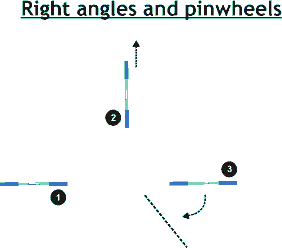|
|
|
|
Things to Do With Only Three JumpsTraining exercises you can do at club or even in your own garden
| |||||||||||||||||||||||||||||||||||
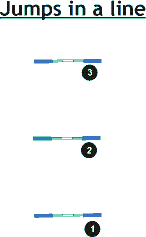
|
1. Run with dog on
your left. |
| 1.
Run dog in both directions (1, 2, 3 and 3, 2, 1) 2. Move 2 further away and see what happens. 3. Move 3 into the indicated position for a larger angle - run again in both directions. |
|
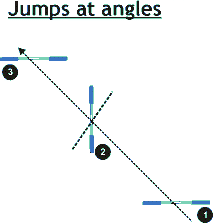
|
A
dog does not necessarily have to take a jump from a 90° approach. However, they need to be taught to take jumps at an angle. In this sequence the dog should follow a straight line, as shown. To make it easier for the beginner dog, try with jump 2 at a less acute angle (shown by the dashed line). Gradually move the jump until it is at right angles to jumps 1 and 3. |
|
|
|
| 1. Again,
the dog should run this sequence in as straight a line as possible. It’s a useful
exercise for teaching the dog to turn away from you (for example from jump 2 to jump 3)
- remember to try the opposite arm here to see if that helps the dog. 2. Try starting in position B - call the dog towards you, then send over 2 and call over 3. 3. Repeat with dog on your right (i.e. start at jump 3). |
|

|
|
| 1. This
sequence is for more experienced dogs. Note that jump 2 must now be taken from the same
direction as jumps 1 and 3. The dog must therefore be “pulled through” the gap
between the jumps. This can take a bit of practice, as the dog will by now be expecting
to take jump 2 from the other direction. 2. Try from 3 - 1. |
|
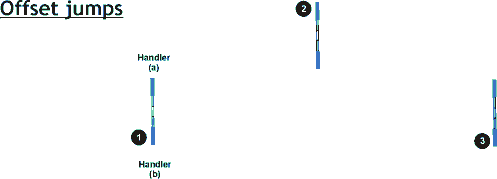
|
|
| 1. Beginner dogs often focus on the obstacle straight ahead of them and will run past jump 2. Practice turning them (a) towards you and (b) away from you. | |

|
There
are lots of ways of doing this - my favourite is this: 1. Dog on handler’s right. Send over black 1 and 2. When dog has the idea, straddle dog and send over black one and two. If all goes well, have the dog on handler’s left and send over black 1 and 2. 2. Repeat for white numbers. |
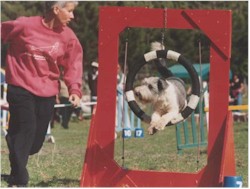 About
the author...
About
the author...
Sally Adam started agility in the early 90's with her Miniature Schnauzer, Ziggy
before there were any mini classes offered at shows. When little dogs were eventually
recognised, Ziggy became the first national mini champion at the age of ten.
Sally now competes with her Beardie (Jaffa) and Border Collie (Tin) and a variety of borrowed dogs. Sally was thrown in at the deep end and asked to start up the agility training class at her club before she had any experience in the sport. With the help of some good books and videos, the class eventually took shape, and Sally has been training and passing on information ever since.
Her proudest agility achievement to date is being a co-founder of the SA Dog Agility Association, which aims to improve the standard of agility and agility judging in South Africa, and to get dog agility into the public eye.
Sally lives in Western Province.
Feedback
From Janet Varley...
Having a new baby to train, and not that much space to do it in, I
found this article really useful indeed... thanks. (21/08/02)
From Jacqui (Western
Australia)...
What a wonderfully informative exercise. I work long hours so rarely
get to train my Standard Poodle. Due to a lung condition I am trying to train her to work away
from me and club training nights generally do not afford us the chance to do repetition work.
Now I can train with a minimum of equipment in my own back garden. Thank you I'll be back to
this site often.
From Sally Wynnes...
<PRE> very informative article and will be useful to pass on at Club so pupils
can practice at home. (25/09/02)
|
[bottom.htm] © Copyright Agilitynet |

 Based
on an article by American Anne E. Smith, South African competitor Sally Adam adapted it for the
South African Dog Agility Association (SADAA) web site on a page devoted to various aspects of
agility training. It is reprinted here with their permission.
Based
on an article by American Anne E. Smith, South African competitor Sally Adam adapted it for the
South African Dog Agility Association (SADAA) web site on a page devoted to various aspects of
agility training. It is reprinted here with their permission.